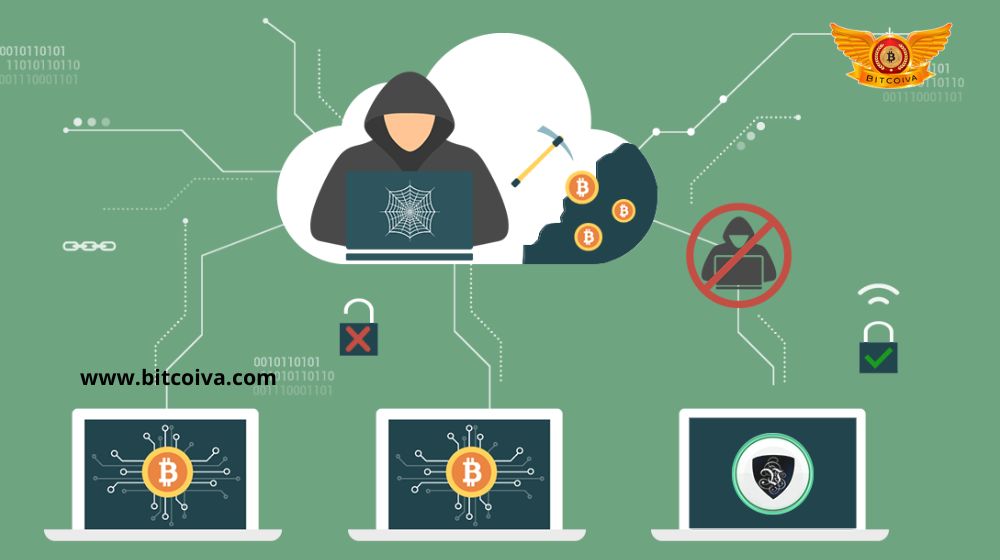An assault called cryptojacking uses a target’s computational capacity to secretly mine cryptocurrency on the hacker’s behalf. Individual customers, enormous institutions, and even industrial control systems can all be the targets of cryptocurrency theft on the crypto exchange India.
As the mining process takes precedence over other legitimate activities. The malware versions used in cryptojacking cause sluggish performance on affected machines.
What is Cryptojacking Theft
There are two methods to acquire cryptocurrency India: buying and mining. Utilizing cryptocurrency exchanges like Binance and Coin base, one can purchase cryptocurrency. On the other hand, by resolving a mathematical puzzle. Miners can obtain bitcoin as a reward through the cryptocurrency mining process.
The digital database updated with information on each transaction. Since the previous update since cryptocurrencies work via a distributed ledger known as blockchain. When individuals known miners contribute computer power in exchange for rewards, blocks created.
However, because mining consumes a lot of electricity and requires expensive equipment. Hackers from all over the world try to use harmful software to obtain bitcoin for free. The term “cryptojacking,” which combines the phrases “cryptocurrency” and “hijacking,” used to describe this kind of criminality.
The several types of cryptojacking. How they operate, and how to spot and stop malicious crypto mining are all covered in this article.
How is Cryptojacking Carried Out
In order to steal bitcoin from cryptocurrency buy in India wallets or to mine coins on victims’ devices. Hackers or cybercriminals implant cryptojacking software into their systems. Through a malicious link included in a phishing email. The devices of the unwary victims have malicious crypto mining programmes installed.
Alternately, hackers add JavaScript code to a website or online advertisement, which launches when the victim’s browser loads it. Each time the cryptojacking software installed and allowed to operate in the background, the victim continues to work.
Regardless of the method used. The script carries out difficult mathematical calculations on the victims’ computers and sends the results to a server under the hacker’s control without endangering the device’s data. However, they do take computer processing power from them.
Only certain users might have a problem with a slower machine. Nevertheless, firms must pay for things like expensive electricity and IT upkeep. Because of the worming ability of crypto mining programmes, other computational resources may also become affected. These scripts may also do a system scan to look for the presence of any other crypto mining malware. If another crypto miner discovered, the script stops it.
Cryptojackers initially mined cryptocurrency using JavaScript script while offering customers free material. If websites are transparent about their activities and the user stays on the website, this tactic might work. Determining if websites are telling the truth is difficult for users.
While the visible windows closed. A hidden browser window is still running as a pop-up behind the clock or below the taskbar. The code makes use of system resources in order to keep the script from found.
Another way to use Android mobile devices for nefarious purposes is to cryptojack miners using a Trojan horse infection or to drive users to malicious websites. A Trojan horse virus is a type of malware. That infects computers by pretending to be a reliable program and gaining access to users’ systems by employing social engineering techniques like phishing.
What Different Forms of Cryptojacking are There
Script preparation, script injection, and the attack are the three main phases of a cryptojacking malware lifecycle. All varieties of crypto mining malware go through the same script preparation and assault phases. The script injection phase, in contrast, done out locally by inserting the malicious code into other apps or onto websites.
Three covert methods primarily used by cryptojackers to mine cryptocurrencies:
Taking charge of the IT environment;
Obtaining malware to launch cryptocurrency mining scripts; and
By means of cloud services.
Browser-based cryptojacking is the practise of injecting malware into a browser via IT infrastructure. For instance, hackers create crypto mining scripts using a programming language and insert them into different websites.
By using old or vulnerable WordPress plugins and advertising. The user’s computer downloads the script’s code, which then automatically run, resulting in cryptojacking.
YouTube and other media content providers are good targets for attackers due to their popularity and the amount of time users spend on those websites. For instance, cryptojacking malware mixed into Google’s ad bundles for YouTube. The victims’ host had put together a hacked advertising package that engaged in illicit mining as long as users stayed on the relevant page. Similar to that, a plugin made available by the UK government had malware that exploited for cryptojacking.

Malicious emails that look legitimate but when clicked execute the crypto mining code without the user’s awareness used to commit file-based cryptojacking.
Cloud-based malware, as opposed to file-based cryptojacking malware, installed on the host machine to get access to the victim’s computational resources. As a result, they frequently delivered to the host system by means of strategies including embedded in third-party software and taking advantage of vulnerabilities.
When using host-based cryptojacking or the cloud, hackers scour a company’s files and source code for application programming interface (API) keys to access their cloud services. Once inside, hackers mine bitcoins using unlimited CPU resources, which increases account fees while mining cryptocurrency without authorization on the cryptocurrency exchange India.
To Perform Host-Based Cryptojacking Attacks, the Following Steps Typically Taken
Cybercriminals’ Techniques for Carrying out Host-Based Cryptojacking Assaults
Once the attacker has received the entire amount in cryptocurrency from the service provider, they have three options for using the money: using top 5 cryptocurrency in India mixing services to hide their tracks, converting to fiat currency using exchanges or peer-to-peer transactions, or using it as a digital currency for a service.
How to Spot Cryptocurrency Theft
In order to prevent unauthorized mining operations from abusing the computational resources of any computing platform without the users’ knowledge or consent, it is crucial to identify and stop the widespread and evolving nature of cryptojacking malware. Cryptojacking detection is challenging despite being important since it varies from traditional malware in a number of ways. You might be able to catch it if you are cautious and keep an eye out for the potential symptoms listed below.
Cybercriminals exploit the computational capability of their victims rather than taking control of them as with traditional malware. Since users usually place their trust in respected websites and do not expect any non-consensual device mining, the virus can utilised on or incorporated into those websites to make them appear trustworthy.
Due to the resource demands of the cryptojacking process, computing systems may overheat, which could shorten their lifespan or even harm them. Overheating on the PC could indicate a problem with your gadget.
Computers that operate poorly, such as those with slow processing rates or apps that regularly crash, may engaged in cryptojacking.
The longer a person stays on a page, the more CPU time cryptojacking scripts consume. Therefore, you might learn about any illegal activity operating on your device by looking at the CPU usage on your computer’s Task Manager.
How to Avoid Being a Victim of Cryptojacking Assaults
Knowing the most recent developments in crypto mining malware might help one defend themselves from cryptojacking because prevention is always better than cure. Recognizing and avoiding cryptojacking may be made easier if you are aware of contemporary cybersecurity concerns.
Malicious malware code can be found and stopped with the help of cryptojacking blockers. Similar to this, Ad Blocker Plus can stop cryptojacking from happening through internet advertisements. To prevent falling prey to crypto mining malware, one can also install cybersecurity solutions like Kaspersky Total Security.
It’s also advised to install the most recent software, operating system, and programme upgrades, especially for web browsers. In addition, JavaScript should be turned off whenever you browse the internet to avoid having your computer infected with cryptojacking malware.
However, it could make it difficult for you to use the essential features.
While online, it’s a good idea to look for cryptojacking websites and add them to a blacklist. Your device can still become infected by fresh crypto mining malware websites, though. Installing internet security software could help you avoid cryptojacking and the ensuing computer or mobile device malfunction.
Visit us at: www.bitcoiva.com

